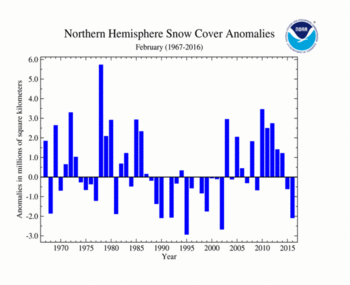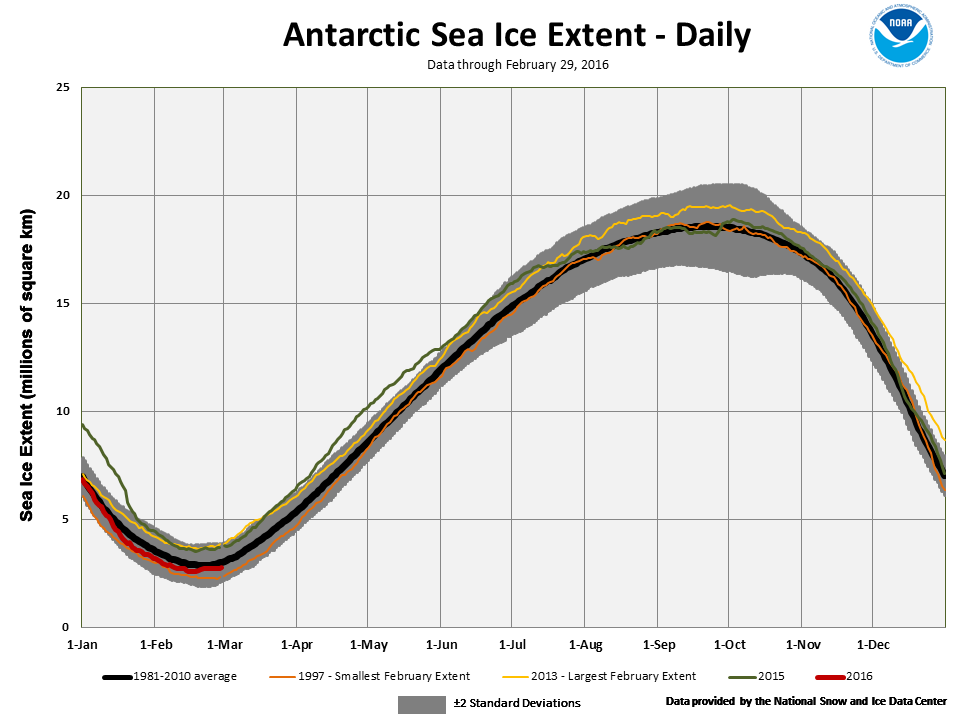NH Snow Cover Extent
| February 2016 | Snow Cover Extent | Anomaly 1991-2020 | Trend per decade | Rank (50 years) | Record | ||||||
|---|---|---|---|---|---|---|---|---|---|---|---|
| million km² | million mi² | million km² | million mi² | million km² | million mi² | Year(s) | million km² | million mi² | |||
| Northern Hemisphere | 45.26 | 17.47 | -0.52 | -0.20 | -0.10 | -0.04 | Largest | 31st | 1978 | 51.32 | 19.81 |
| Smallest | 20th | 1990 | 42.16 | 16.28 | |||||||
| North America | 17.35 | 6.70 | +0.14 | +0.05 | +0.06 | +0.02 | Largest | 24th | 1978 | 19.04 | 7.35 |
| Smallest | 27th | 1991 | 15.63 | 6.03 | |||||||
| Eurasia | 27.92 | 10.78 | -0.64 | -0.25 | -0.16 | -0.06 | Largest | 36th | 1972 | 33.26 | 12.84 |
| Smallest | 15th | 2002 | 25.91 | 10.00 | |||||||
Data Source: Global Snow Laboratory, Rutgers University. Period of record: 1967–2016 (50 years)
During February 2016, the Northern Hemisphere snow cover extent (SCE) was 43.51 million square km (16.80 million square miles), 2.08 million square km (800,000 square miles) below the 1981-2010 average. This was the third smallest February Northern Hemisphere SCE in the 50-year period of record, and the smallest since 2002. The Eurasian SCE was the fourth smallest on record while the North American SCE was the 13th smallest. For the winter season (December 2015-February 2016), the Northern Hemisphere SCE was 120,000 square km (46,000 square miles) below the 1981-2010 average — the 20th smallest winter SCE for the Northern Hemisphere and the smallest since 2006/07. The 2015/16 winter SCE for the Northern Hemisphere was slightly less than the SCE from the previous winter in 2014/15.
The February North American snow cover extent was 16.68 million square km (6.44 million square miles), 440,000 square km (170,000 square miles) below average. This was the 13th smallest February SCE on record, and the smallest since 2005. In the U.S., above-average snow cover was observed in parts of the Northwest, Central Plains, and Midwest while below-average snow cover was observed in the Northern Rockies and Northeast. Across Canada, above-average snow cover was observed on the west side of the Rockies, with below-average snow cover in parts of the southern prairies. The winter SCE for North America was 150,000 square km (58,000 square miles) above the 1981-2010 average, the 19th largest winter SCE for the continent.
The Eurasian SCE during February was 26.83 million square km (10.36 million square miles), 1.65 million square km (640,000 square miles) below average. This was the fourth smallest February Eurasian SCE on record and the smallest since 2002. Above-average snow cover was observed for parts of the European Alps, Mongolia, and eastern China. Below-average snow cover was observed for most of Europe, Turkey, Iran, Kazakhstan, southern Russia, and the Tibetan Plateau. For the winter season, the Eurasian SCE was 270,000 square km (104,000 square miles) below average and the 16th smallest winter SCE for the continent and smallest since 2006/07.
Sea Ice Extent
| February 2016 | Sea Ice Extent | Anomaly 1991-2020 | Trend per decade | Rank (38 years) | Record | ||||
|---|---|---|---|---|---|---|---|---|---|
| million km² | million mi² | Year(s) | million km² | million mi² | |||||
| Northern Hemisphere | 14.20 | 5.48 | -4.44% | -2.96% | Largest | 38th | 1979 | 16.18 | 6.25 |
| Smallest | 1st | 2016 | 14.20 | 5.48 | |||||
| Southern Hemisphere | 2.79 | 1.08 | -9.71% | +3.88% | Largest | 33rd | 2008 | 3.89 | 1.50 |
| Smallest | 6th | 1993 | 2.48 | 0.96 | |||||
| Globe | 16.99 | 6.56 | -5.35% | -1.78% | Largest | 36th | 1979 | 19.32 | 7.46 |
| Smallest | 3rd | 2011 | 16.88 | 6.52 | |||||
Data Source: National Snow and Ice Data Center (NSIDC). Period of record: 1979–2016 (38 years)
According to the National Snow and Ice Data Center (NSIDC), the Northern Hemisphere (Arctic) sea ice extent — which is measured from passive microwave instruments onboard NOAA satellites — averaged for February 2016 was 14.22 million square km (5.49 million square miles), 1.16 million square km (450,000 square km), or 7.54 percent, below the 1981-2010 average. This was the smallest February sea ice extent on record for the Arctic, 180,000 square km (70,000 square miles) smaller than the previous record in 2005. February is the second consecutive month with record-low Arctic sea ice. Arctic sea ice typically expands during the cool season, reaching the maximum extent in mid-March. However, in February 2016, sea ice did not expand during the first three weeks of the month, with a slight increase towards the end of the month. The Arctic was much warmer than average during January and February, limiting ice expansion during the latter part of winter. During February in the Arctic, sea ice extent was below average in the Barents, Kara, and East Greenland seas and the Gulf of St. Lawrence on the Atlantic side and the Bering Sea on the Pacific side. Sea ice extent actually decreased in the Barents and East Greenland seas. Sea ice levels were near average for the Sea of Okhotsk, Baffin Bay, and the Labrador Sea. February Arctic ice extent is decreasing at an average rate of 2.9 percent per decade.
The February Southern Hemisphere sea ice extent was 2.75 million square km (1.06 million square miles), which was 290,000 square km (110,000 square miles), or 9.54 percent, below the 1981-2010 average. This was the sixth smallest Southern Hemisphere sea ice extent on record and the smallest since 2006. The February 2016 Southern Hemisphere sea ice extent was much smaller than the record and near-record large February extents that occurred in 2013, 2014, and 2015. Southern Hemisphere sea ice extent is increasing at an average rate of 4.0 percent per decade, with substantial inter-annual variability.
On February 19th the sea ice extent in the Southern Hemisphere reached its annual minimum extent at 2.6 million square kilometers (1.0 million square miles). This was the ninth lowest Antarctic sea ice minimum extent in the satellite record. The annual minimum extent has varied greatly over the past few years, approaching record low levels in 2011 and record high levels in 2013.
For further information on the Northern and Southern Hemisphere snow and ice conditions, please visit the NSIDC News page.
 NOAA's National Centers for Environmental Information
NOAA's National Centers for Environmental Information





